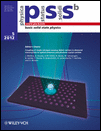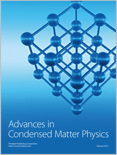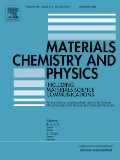
Journal of Physics-Materials
Scope & Guideline
Pioneering Research in Atomic and Molecular Physics
Introduction
Aims and Scopes
- Materials Characterization and Modeling:
The journal emphasizes in-depth characterization techniques and modeling approaches to understand material properties at atomic and macroscopic scales, enabling predictive insights into material behavior. - Nanomaterials and Nanotechnology:
A significant focus on nanomaterials, including their synthesis, characterization, and applications, particularly in electronics, photonics, and energy storage. - Magnetism and Magnetic Materials:
Research on magnetic materials, including studies on magnetic anisotropy, magnetoresistance, and spintronic applications, reflecting a core area of interest within the journal. - Superconductivity and Quantum Materials:
The journal covers advancements in superconductivity, topological materials, and quantum phenomena, contributing to the understanding of emergent properties in novel materials. - Functional Materials for Energy Applications:
A commitment to exploring functional materials for energy conversion and storage, including photovoltaics, batteries, and electrocatalysts, highlighting the journal's relevance to sustainable technologies. - Biomaterials and Soft Matter:
Research on biomaterials and soft matter systems, focusing on their applications in biomedical fields and their unique physical properties.
Trending and Emerging
- Machine Learning in Materials Science:
An increasing trend towards utilizing machine learning techniques for materials discovery, property prediction, and process optimization, showcasing the integration of AI with materials research. - 2D Materials and Heterostructures:
A significant rise in studies focusing on two-dimensional materials and their heterostructures, emphasizing their unique properties and potential applications in electronics and optoelectronics. - Sustainable and Green Materials:
Growing interest in sustainable materials, including recyclable and low-environmental-impact materials, reflecting a broader societal push towards sustainability in materials science. - Advanced Characterization Techniques:
Emerging methodologies in materials characterization, such as advanced microscopy and spectroscopy techniques, are gaining traction, allowing for deeper insights into material properties at the nanoscale. - Quantum Materials and Topological Phenomena:
An increasing focus on quantum materials and topological phenomena, highlighting their potential for revolutionary applications in quantum computing and advanced electronics. - Functionalization and Hybrid Materials:
Research on the functionalization of materials and the development of hybrid materials that combine different functionalities is trending, reflecting the demand for multifunctional applications in various domains.
Declining or Waning
- Traditional Bulk Materials:
Research on conventional bulk materials has seen a decline as the focus shifts towards nanostructured and advanced materials, which offer superior properties and functionalities. - Low-Dimensional Materials Beyond Graphene:
Interest in low-dimensional materials, particularly those beyond graphene, appears to be waning as the field matures and researchers increasingly focus on specific applications and hybrid materials. - Classical Photonic Materials:
The exploration of classical photonic materials has decreased as attention moves towards novel photonic structures and metamaterials that exploit advanced light-matter interactions. - Conventional Semiconductor Devices:
Research on traditional semiconductor devices is declining in favor of exploring new materials and architectures that can enhance performance and enable new functionalities.
Similar Journals

JOURNAL OF LOW TEMPERATURE PHYSICS
Connecting global researchers in the quest for scientific excellence.Journal of Low Temperature Physics, published by Springer/Plenum Publishers, is a prominent academic journal dedicated to the fields of low temperature physics, condensed matter physics, and materials science. With a rich history dating back to its inception in 1969, this journal has served as a critical platform for disseminating innovative research and advancements in atomic, molecular, and condensed matter physics. As of 2023, it holds a Q3 rank in various categories, including Atomic and Molecular Physics, Condensed Matter Physics, and Materials Science, reflecting its significant contribution to the scientific community. While currently not open access, the journal is indexed in leading databases, making it accessible to a global audience. Researchers, professionals, and students will find valuable insights and peer-reviewed studies that push the boundaries of low temperature experimental and theoretical physics. For comprehensive discussions that bridge theory and application, Journal of Low Temperature Physics stands out as an essential resource in the pursuit of scientific excellence.

PHYSICA STATUS SOLIDI B-BASIC SOLID STATE PHYSICS
Driving Progress in Fundamental Material PropertiesPHYSICA STATUS SOLIDI B-BASIC SOLID STATE PHYSICS, published by Wiley-VCH Verlag GmbH in Germany, is an esteemed journal within the condensed matter physics sphere, covering pivotal advancements in basic solid state physics. With a rich history dating back to 1961, it serves as a scholarly platform for researchers, professionals, and students alike, providing insights into the fundamental properties and applications of electronic, optical, and magnetic materials. The journal currently holds a respectable Q3 ranking in both Condensed Matter Physics and Electronic, Optical, and Magnetic Materials as of 2023, indicating its impactful contributions to these fields despite its competitive landscape. While it does not offer open access, its comprehensive research findings are critical for those engaged in innovative material science research. With a convergence period extending to 2024, PHYSICA STATUS SOLIDI B continues to play a significant role in facilitating knowledge exchange and fostering advancements in solid state physics.

Advances in Condensed Matter Physics
Unveiling Innovations in Condensed Matter ResearchAdvances in Condensed Matter Physics is a distinguished journal published by HINDAWI LTD, dedicated to the rapid dissemination of high-quality research in the field of condensed matter physics. Since its inception in 2008, this Open Access journal has facilitated wide accessibility to cutting-edge findings and theoretical advancements, with aims to foster collaboration and innovation within the scientific community. With an ISSN of 1687-8108 and an E-ISSN of 1687-8124, the journal covers an extensive range of topics, from quantum materials to nanotechnology, ensuring relevance and engagement across various sub-disciplines. As a testament to its impact in the field, it is ranked in the Q3 category for 2023 within Scopus and holds a position in the 34th percentile for physics and astronomy. The journal's continuous commitment to publishing significant exploratory research until 2024 makes it a pivotal resource for researchers, professionals, and students eager to stay on the leading edge of condensed matter physics advancements.

JETP LETTERS
Bridging Tradition and Innovation in Scholarly ResearchJETP LETTERS, published by MAIK NAUKA/INTERPERIODICA/SPRINGER, is a prestigious journal in the field of physics and astronomy, which plays a pivotal role in disseminating groundbreaking research and innovative ideas since its inception in 1969. With an ISSN of 0021-3640 and an E-ISSN of 1090-6487, this journal aligns well with the interests of both seasoned researchers and emerging scholars, having achieved a 2023 category rank of Q3 for miscellaneous topics within physics and astronomy. Located in the United States at 233 SPRING ST, NEW YORK, NY 10013-1578, JETP LETTERS serves as a critical resource for its readership, offering exclusive insights and advancements across diverse areas of physics. While not open access, it hosts a collection of articles that refine theoretical approaches and experimental methods, providing both knowledge and inspiration to professionals and academics seeking to make impactful contributions to the scientific community. The journal’s quality is reflected in its Scopus ranking, where it stands at 39 out of 81 in the multidisciplinary category, placing it in the 52nd percentile, thus underscoring its significance and reliability as a scholarly outlet.

MATERIALS CHEMISTRY AND PHYSICS
Exploring the Frontiers of Materials InnovationMATERIALS CHEMISTRY AND PHYSICS is a leading peer-reviewed journal published by Elsevier Science SA, focusing on the intersection of materials science and condensed matter physics. With an esteemed impact factor and a distinguished reputation in its field, this journal holds a Q1 ranking in Condensed Matter Physics and a Q2 ranking in miscellaneous Materials Science categories as of 2023. Spanning over three decades since its inception in 1983, it provides a vital platform for researchers, professionals, and students to disseminate cutting-edge findings and innovations in materials characterization, properties, and applications. The journal is indexed in Scopus, boasting impressive rankings that reflect its commitment to publishing high-quality research. Although it does not currently offer an Open Access option, it remains an essential resource for those seeking to stay at the forefront of materials chemistry and physics.

JOURNAL OF THE PHYSICAL SOCIETY OF JAPAN
Empowering Scholars through Cutting-edge DiscoveriesThe JOURNAL OF THE PHYSICAL SOCIETY OF JAPAN, published by the Physical Society of Japan, has been at the forefront of advancing knowledge in the field of Physics and Astronomy since its inception in 1946. With a commendable reputation reflected in its Q2 ranking within its category for 2023, this journal serves as a vital platform for disseminating high-quality research and innovative concepts. Researchers and professionals alike can engage with cutting-edge studies and reviews that span a diverse range of topics pivotal to the physical sciences. Although the journal does not currently operate with an open access model, it maintains a robust impact on the global physics community, evidenced by its placement in the 59th percentile among a competitive pool of 243 journals. With an unwavering commitment to bridging theory and application, the JOURNAL OF THE PHYSICAL SOCIETY OF JAPAN continues to inspire and cultivate scholarly discourse and collaboration across disciplines.

JOURNAL OF MATERIALS SCIENCE-MATERIALS IN ELECTRONICS
Advancing the Frontiers of Materials in ElectronicsJOURNAL OF MATERIALS SCIENCE-MATERIALS IN ELECTRONICS, published by Springer, is a distinguished international journal that serves as a vital platform for the dissemination of cutting-edge research in the field of materials science, with a keen focus on electronics. Since its inception in 1990, this journal has consistently contributed to the advancement of knowledge across a range of interdisciplinary categories, including Atomic and Molecular Physics, Optical and Magnetic Materials, and Biomedical Engineering, achieving notable quartile positions in various 2023 Scopus rankings. With an impact factor that signifies its scholarly influence, this journal provides a rigorous peer-reviewed environment for researchers and practitioners to share innovative ideas, experimental findings, and theoretical developments. Although it does not currently offer open access options, the depth and breadth of topics covered—including condensed matter physics and bioengineering—make it an essential resource for those at the forefront of materials research. With a commitment to bridging the gap between theory and practical application, the JOURNAL OF MATERIALS SCIENCE-MATERIALS IN ELECTRONICS continues to pave the way for future explorations in the ever-evolving landscape of materials science.

Journal of Superconductivity and Novel Magnetism
Unveiling the Mysteries of Superconducting MaterialsJournal of Superconductivity and Novel Magnetism, published by SPRINGER, is a premier venue for research in the dynamic fields of condensed matter physics and materials science. With an ISSN of 1557-1939 and an E-ISSN of 1557-1947, this journal provides an essential platform for disseminating innovative studies examining the complexities of superconductivity and magnetic phenomena. The journal is recognized for its contributions, holding a Q3 quartile ranking in both condensed matter physics and electronic, optical, and magnetic materials as of 2023. With a commitment to rigor and relevance, it features research that breaks new ground in understanding the properties and applications of superconducting materials, aiming to bridge fundamental science with technological advancements. Despite its lack of open access, the journal remains pivotal for researchers, professionals, and students keen to stay abreast of cutting-edge developments in the field, making it an indispensable resource for cultivating knowledge and promoting collaboration.

EUROPEAN PHYSICAL JOURNAL B
Driving Progress in Vital Areas of PhysicsEUROPEAN PHYSICAL JOURNAL B (ISSN: 1434-6028, E-ISSN: 1434-6036), published by Springer, is a prominent international journal based in Germany that focuses on the fields of Condensed Matter Physics and Electronic, Optical and Magnetic Materials. With a converged publication timeline from 1998 to 2024, it caters to a diverse audience that includes researchers, professionals, and students striving for the latest advancements in these vital areas of physics. The journal is recognized with a Q3 ranking in both relevant categories for 2023, showcasing its solid yet notable standing within the academic community. Although currently without an H-index, its Scopus rankings reflect a percentile performance of 41st and 39th, respectively, indicating a growing influence among its peers. The journal offers open access options, ensuring that groundbreaking research is widely accessible and contributes to the collective knowledge within the scientific domain. By aiming to publish high-quality, well-researched articles, the EUROPEAN PHYSICAL JOURNAL B plays a crucial role in disseminating innovative findings and fostering collaboration in the field of physics.

MICROELECTRONIC ENGINEERING
Advancing the Frontiers of Microelectronics and NanotechnologyMICROELECTRONIC ENGINEERING is an esteemed journal published by Elsevier, focusing on the rapidly evolving fields of microelectronics and nanotechnology. It encompasses a wide array of topics, including atomic and molecular physics, condensed matter physics, and the engineering aspects of electronic, optical, and magnetic materials. With its impressive impact factor and recognition as a Q2 journal in several categories, it provides an invaluable platform for researchers and professionals to disseminate their groundbreaking findings. The journal has been instrumental in advancing our understanding and application of microelectronic technologies since its inception in 1983. Currently ranked highly within various specialized categories in Scopus, MICROELECTRONIC ENGINEERING offers targeted access to cutting-edge research, fostering innovation and collaboration in the world of electronic engineering and materials science. As we look towards the future, with convergence continuing to shape research until 2024, the journal remains a critical resource for those dedicated to pushing the boundaries of knowledge in these dynamic fields.